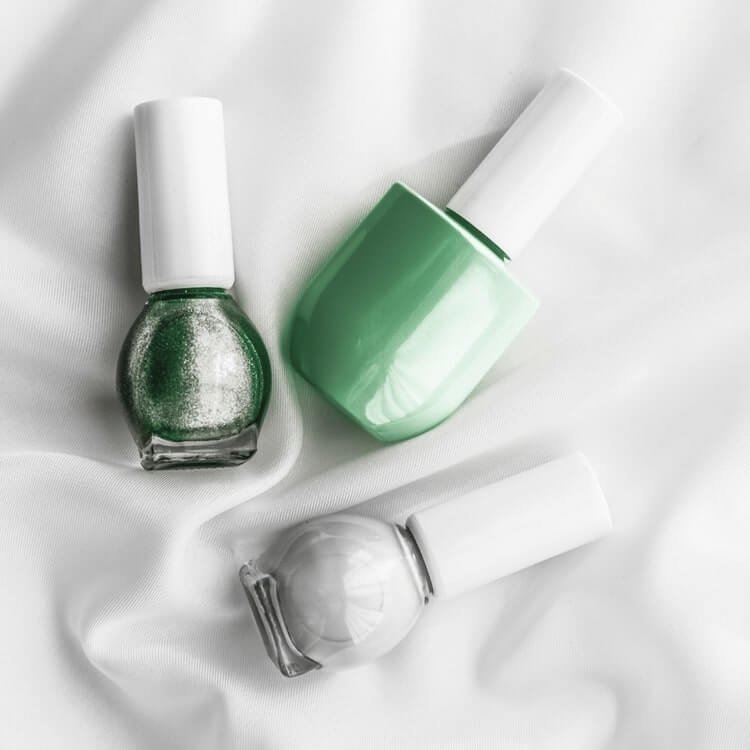Heads up! We may use affiliate links in this post. You'll never pay more, but we might earn a small commission if you buy - thanks for supporting us! See our full disclosure here.
If you’ve ever found yourself standing in the nail aisle, confusingly squinting at the bottles labelled “nail lacquer” and “nail polish”, don’t worry—you’re not alone!
Today, we’re breaking down the differences between Nail Lacquer vs Nail Polish to help you make informed choices for your next manicure and clear up the confusion once and for all!
These two popular products have some key distinctions that can affect your nail care routine and results.
Let’s explore what sets them apart.
Nail Polish: The Classic Choice
Nail polish is what most people think of when they imagine a manicure.
It’s been around for a long time and is known for its straightforward formula, which usually includes pigments, solvents, and resins.
Nail polish gives your nails colour and shine and typically requires a base coat and a top coat for the best results.
Pros:
Variety: Nail polish comes in countless shades and finishes. Whether you’re into matte, glossy, or glitter, there’s a polish for you.
Ease of Use: Most nail polishes are easy to apply and are suitable for at-home manicures. They often come with user-friendly brushes and formulas.
Affordability: Generally more budget-friendly, allowing you to experiment with different colours and finishes without spending a fortune.
Cons:
Chipping: Nail polish can chip more easily, especially if you’re hard on your nails. This might mean more frequent touch-ups.
Drying Time: It often takes a bit longer to dry compared to some lacquers, which might be inconvenient if you’re in a hurry.
Our Top Picks For Nail Polish
YOU MIGHT LIKE THESE TOO:
- A Complete Guide To Nail Enhancements: Choosing What’s Right for You
- 10 Different Nail Shapes Explained: Almond, Stiletto & more
- Can You Use Argan Oil To Grow And Strengthen Your Nails?
Nail Lacquer: The Sophisticated Option
Nail lacquer is a term used for a product that’s similar to nail polish but with some differences.
Lacquer usually has a higher concentration of resins, which can result in a more durable and glossy finish.
It often dries faster and is designed to be more resistant to chipping.
Pros:
Durability: Nail lacquers are typically more resistant to chipping, making them a good choice if you need your manicure to last longer.
High Shine: They often provide a glossier finish, giving your nails a polished look.
Faster Drying: Many lacquers dry quicker than traditional nail polish, so you can get on with your day sooner.
Cons:
Cost: Nail lacquers can be more expensive than standard nail polish.
Removal: Some lacquers might be a bit harder to remove, especially if they are long-wearing formulas.
Our Top Picks For Nail Polish
Differences In Their Ingredients and Formulations
Understanding the ingredients in nail polish and lacquer can help you make better choices.
Both products typically contain similar components, such as solvents (to dissolve the other ingredients and help with application), pigments (for colour), and resins (for a glossy finish and durability).


However, the concentration and types of these ingredients can vary between products.
For instance, nail lacquers often have higher resin content, which enhances their durability and shine.


Some lacquers also include additional ingredients like formaldehyde or toluene, which can be harsh.
If you’re looking for more natural options, some brands like Nail Polish Direct and Butter London now offer “five-free” or “ten-free” lacquers that avoid these potentially harmful chemicals.
Which One Should You Choose?
The choice between nail polish and nail lacquer really depends on what you’re looking for in your manicure.
If you’re interested in trying out different colours and finishes frequently and don’t mind doing touch-ups, nail polish is a great option.
On the other hand, if you want something that lasts longer and maintains a high-shine finish, nail lacquer might be the better choice.
Feel free to mix and match based on your needs and preferences. Your nails are a great way to express yourself, so choose what makes you feel confident and happy.
Save on Pinterest for later?


FAQs
Q. Can I Use Nail Polish Over Nail Lacquer?
Yes, you can use nail polish over nail lacquer, but there are a few things to consider.
Nail lacquer often has a more durable and glossy finish, so applying regular nail polish on top might affect the final look and longevity.
If you do choose to layer them, ensure that each layer is fully dry before applying the next to avoid smudging or peeling.
For a smooth finish, consider using a top coat that works well with both products.
Q. How Can I Make My Manicure Last Longer?
To extend the life of your manicure, follow these tips:
Apply a Base Coat: This helps the polish adhere better to your nails and prevents staining.
Use a Quality Top Coat: A good top coat not only adds shine but also protects against chipping and extends the wear of your manicure.
Avoid Excessive Water Exposure: Prolonged exposure to water can weaken the polish. Try wearing gloves while washing dishes or cleaning.
Avoid Picking or Biting: Resist the urge to pick at or bite your nails, as this can lead to chipping and peeling.
Do Regular Touch-Ups: Keep a small bottle of your polish or lacquer handy for quick touch-ups.
Q. Are There Any Health Concerns With Nail Products?
Yes, some nail products contain chemicals that might raise health concerns, especially with prolonged use or in sensitive individuals.
Here are a few common concerns:
Formaldehyde: Found in some nail lacquers, formaldehyde can be irritating and is considered a potential carcinogen.
Toluene: This solvent, present in many nail products, can cause respiratory issues and is also potentially harmful with long-term exposure.
Phthalates: These chemicals, sometimes included to improve flexibility, have been linked to various health concerns.
To minimise risks, look for “five-free” or “ten-free” products, which are free from these potentially harmful chemicals. Opting for natural or hypoallergenic nail products can also be a safer choice.
Q. What Is The Difference Between “Quick-dry” and “Regular” Nail Polish?
“Quick-dry” nail polish is formulated to dry faster than regular nail polish.
It contains special solvents and ingredients that evaporate quickly, allowing you to get on with your day sooner.
While convenient, quick-dry formulas may sometimes be slightly more prone to chipping compared to regular polishes.
Regular nail polish generally takes longer to dry but can offer a more durable finish if used with a good top coat.
Q. How Do I Remove Nail Polish or Lacquer Without Damaging My Nails?
To remove nail polish or lacquer safely:
Use a Gentle Remover: Opt for acetone-free nail polish removers, which are less drying and gentler on your nails and cuticles.
Soak and Wipe: Soak a cotton pad in remover and hold it on your nail for a few seconds before wiping away the polish. This helps break down the polish without excessive rubbing.
Avoid Scraping: Don’t use metal tools to scrape off stubborn polish, as this can damage your nails. If needed, use a soft nail buffer or reapply remover to break down any remaining polish.













